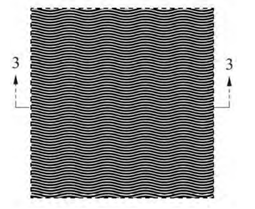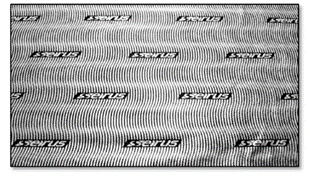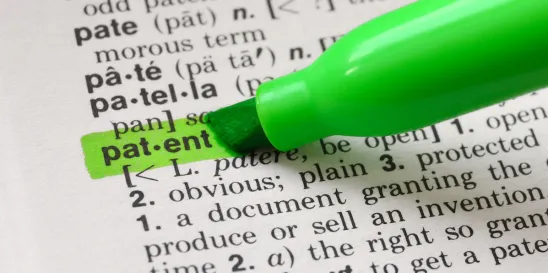Addressing a matter of first impression concerning the scope of prior art relevant to a design patent infringement analysis, the US Court of Appeals for the Federal Circuit concluded that “to qualify as comparison prior art, the prior-art design must be applied to the article of manufacture identified in the claim.” Columbia Sportswear North America, Inc. v. Seirus Innovative Accessories, Inc., Case Nos. 21-2299; -2338 (Fed. Cir. Sept. 15, 2023) (Prost, Reyna, Hughes, JJ.)
Columbia owns a design patent that covers an ornamental design of a heat reflective material. Seirus markets and sells products (e.g., gloves) made with material that it calls HeatWave. An image of Columbia’s patented design and Seirus’s HeatWave material appear below:

Columbia Patented Design

Seirus HeatWave
Columbia sued Seirus for infringement. After the district court granted summary judgment of infringement, Seirus appealed to the Federal Circuit. The Court issued its decision in Columbia I, concluding that the district court improperly declined to consider the effect of Seirus’s logo in its infringement analysis and resolved certain issues that should have been left to the jury. The Court therefore vacated summary judgment and remanded for further proceedings.
On remand, the district court held a trial. Before trial, the district court limited admissible comparison prior art to “wave patterns of fabric,” declined to instruct the jury that “prior art” referred to prior designs of the claimed article of manufacture, and declined to instruct the jury that it did not need to find that any purchasers were deceived or that there was any actual or likelihood of confusion among consumers in the marketplace. Seirus was permitted to admit three prior art references that disclosed fabric, and Columbia was precluded from distinguishing the references by arguing that they did not disclose heat reflective material. The jury returned a verdict of noninfringement. Columbia appealed.
Among other things, Columbia challenged the exclusion of evidence and jury instructions concerning comparison prior art, and the jury instructions implicating Seirus’s logo.
The Federal Circuit began by discussing the appropriate prior art comparison in the context of design patent infringement. Citing its 2008 en banc decision in Egyptian Goddess v. Swisa, the Court explained that under the ordinary-observer test governing design patent infringement, prior art can help highlight distinctions and similarities between the claims and the accused design. For instance, when a claimed design is close to a prior art design, small differences between the accused design and the claim design are likely to be important. Conversely, if an accused design copied a particular feature of the claimed design that departs from the prior art, the accused design is likely to be regarded as deceptively similar to the claimed design, and thus infringing.
The question of first impression before the Federal Circuit was the proper scope of comparison prior art that may be used in the infringement analysis. The Court held that to qualify as comparison prior art, the prior art design must be applied to the article of manufacture identified in the claim. The Court provided several reasons for its holding. First, the Court explained that the prior art’s purpose is to inform an ordinary observer’s comparison between the claimed and accused designs, and the prior art design will help that comparison only to the extent it is also applied to the claimed article of manufacture. Second, the requirement conforms with other cases where courts considered the role of comparison prior art. Third, using the same scope of anticipatory prior art and comparison prior art makes good practical sense.
Returning to the case at hand, the Federal Circuit concluded that the district court erred by failing to instruct the jury about the scope of the asserted patent (i.e., design for heat reflective material). The Court explained that the jury was not provided with the correct standard for determining whether an admitted prior art reference qualified as comparison prior art—namely, whether the prior art disclosed a design applied to the article of manufacture identified in the claim. The Court noted that on remand, the district court was likely to be confronted with questions about what qualifies as heat reflective material. The Court therefore advised the district court that it may wish to construe that term.
The Federal Circuit turned next to Columbia’s jury instruction challenges related to Seirus’s logo. Columbia argued that the jury instructions were erroneous for not specifying that consumer confusion as to source is irrelevant to design patent infringement and that a jury must find a likelihood of confusion to find infringement. The Court acknowledged that design patent infringement does not consider consumer confusion as to source and infringement cannot be avoided by labelling but explained that logos are not irrelevant either. Just because a consumer might not be confused about a accused product’s source, that alone does not preclude an infringement finding. At the same time, a logo has the potential to render an accused design dissimilar to the patented design such that noninfringement can be established.
Applying these legal principles, the Federal Circuit found no error in the jury instruction since the district court correctly explained that it must find purchasers were confused in order to find infringement. Columbia argued that the district court erred by not going further—it should have added that consumer confusion or likelihood of confusion is irrelevant for design patent infringement. The Court disagreed, finding that the district court gave the jury the ordinary-observer test materially similar to the way the Supreme Court has stated the test. Even though the Federal Circuit found no error in the district court’s instruction here, the Court appreciated the potential for a jury to be led astray and mistakenly conflate the significance of a logo’s source-identifying function with whatever impact it might have on comparison of designs. However, the Court stated that district courts are best positioned to make that determination.
The Court therefore vacated the noninfringement finding and remanded for further proceedings.




 />i
/>i

